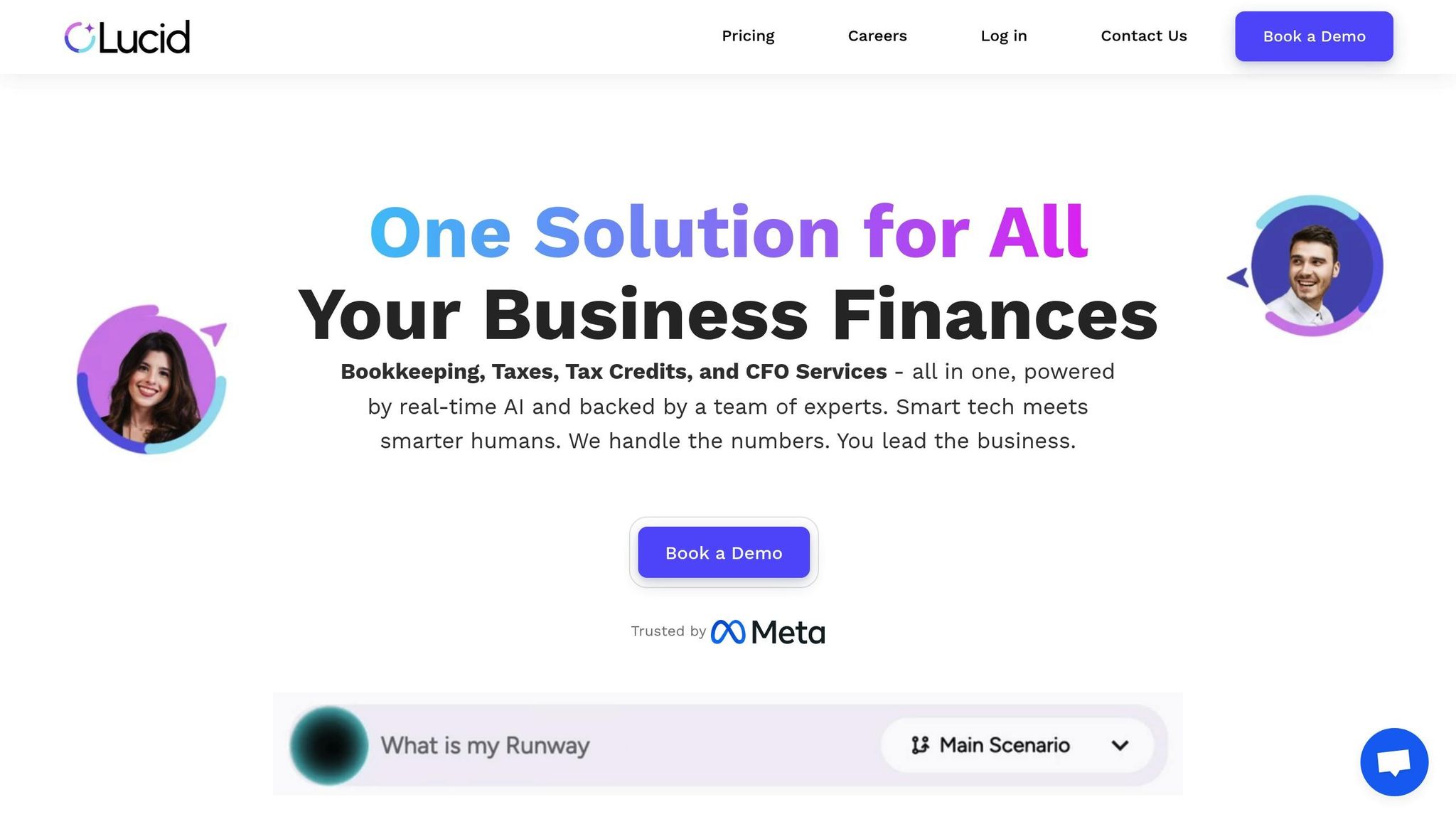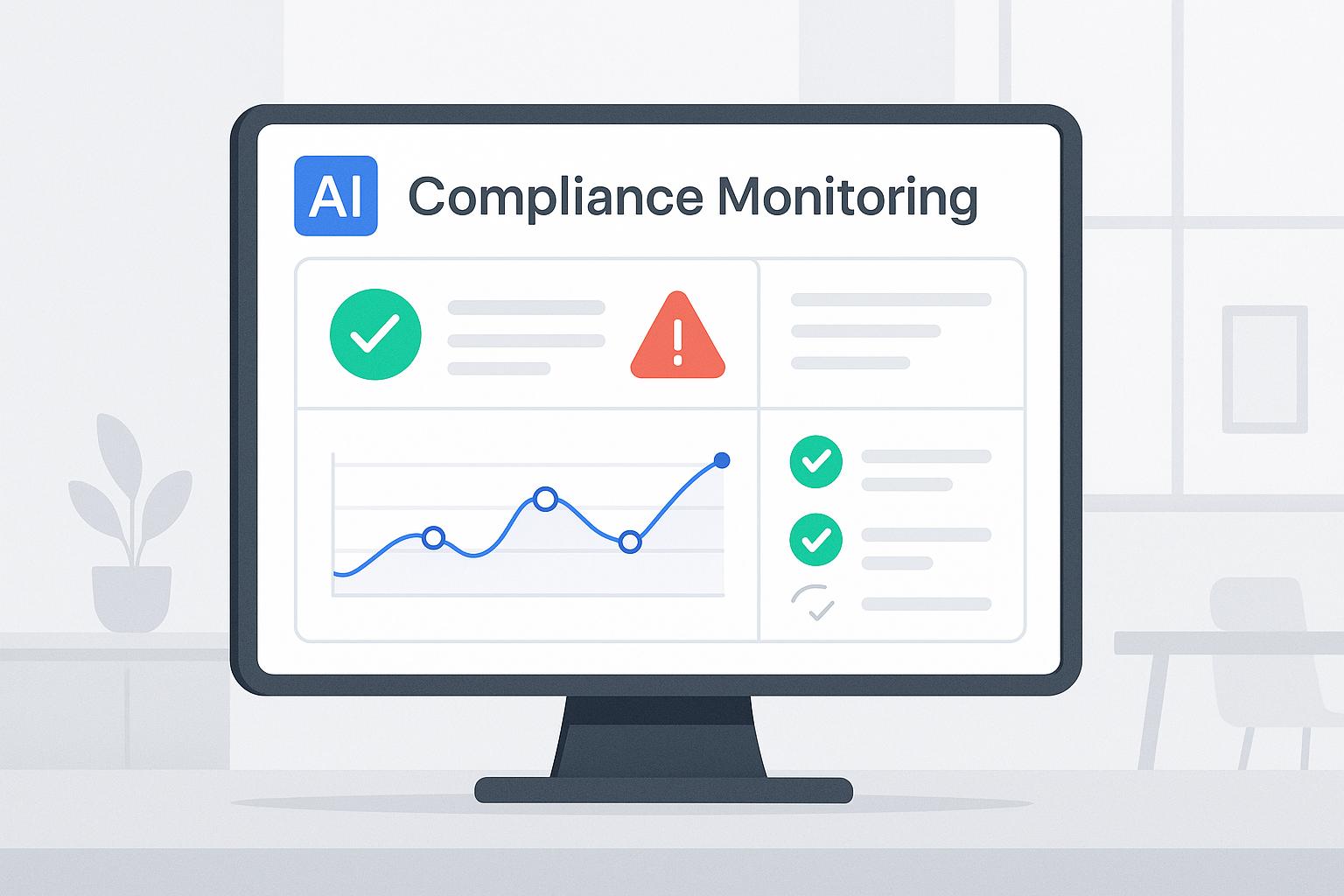Seasonal forecasting predicts business trends by analyzing past patterns, helping companies prepare for revenue changes. Startups, especially in the U.S., rely on accurate forecasts to manage cash flow, inventory, and investor trust. But are manual methods enough in today’s fast-moving markets? AI-driven forecasting offers faster, more precise, and scalable solutions by integrating diverse data sources like sales, social media, and economic signals. Unlike manual methods, which are error-prone and slow, AI systems adapt in real-time, making them better suited for growing businesses.
Key differences:
- Speed: AI processes data in minutes; manual methods take hours or days.
- Accuracy: AI reduces errors by up to 50%.
- Scalability: AI handles large datasets effortlessly, while manual methods struggle.
For startups, AI tools like Lucid Financials provide instant forecasts, real-time insights, and investor-ready reports, saving time and improving decision-making. While manual forecasting may suffice for small businesses, AI is better for companies aiming to grow and stay competitive.
Manual Seasonal Forecasting Methods
Core Methodologies
Manual seasonal forecasting has long relied on a handful of tried-and-true techniques. One of the most straightforward methods is straight-line forecasting, which assumes future growth will follow the same linear trend observed in historical data. Another common approach is the moving average, which smooths out short-term fluctuations by averaging a fixed number of past periods - like a 12-month span - to highlight broader trends. For those seeking more precision, ARIMA models (short for autoregressive integrated moving average) combine autoregression, differencing, and moving averages. While ARIMA can provide deeper insights, it requires a solid grasp of statistics and regular adjustments to stay accurate. These methods offer a foundation, but their limitations often become apparent in practice.
Limitations of Manual Forecasting
Despite their widespread use, manual forecasting methods come with notable drawbacks. For instance, error rates in volatile markets can climb as high as 50%, largely because these methods struggle to process complex, multi-source data or adapt to fresh inputs. Scalability is another hurdle - manual techniques might work for small datasets, but as transaction volumes grow, the time spent on data entry, validation, and analysis increases significantly. Moreover, these models are inherently static, requiring frequent updates to stay relevant. This rigidity makes them less effective when faced with rapid changes like evolving consumer preferences, supply chain disruptions, or sudden economic shifts. For startups, the resource-intensive nature of manual forecasting can be a particular challenge, as they often lack the staff or bandwidth to maintain accurate, ongoing projections.
Use Case: Seasonal Revenue Projections
Consider a retail startup planning for the holiday season. By analyzing years of past sales data and applying a moving average, they might estimate seasonal revenue. While this approach provides a starting point, it often falls short in capturing unexpected changes - like a sudden shift in consumer trends or external market disruptions. This can lead to issues like overstocked inventory or missed revenue targets if the forecast doesn’t align with real-time market conditions. Additionally, manual methods often delay the identification of discrepancies, leaving businesses with little time to pivot. This lag can impact their ability to seize key seasonal opportunities or mitigate potential losses effectively.
AI-Driven Seasonal Forecasting
How AI Forecasting Works
AI-driven seasonal forecasting is changing the game for revenue predictions by using machine learning algorithms that can process complex datasets far beyond the reach of traditional methods. Unlike manual forecasting, which often leans heavily on historical sales data, AI systems pull in multiple data sources at once - everything from real-time market trends and weather patterns to social media sentiment and economic signals.
Here’s how it works: First, data collection pipelines automatically gather information from various sources. Then, data cleaning tools ensure everything is accurate and ready for analysis. From there, advanced models - like regression, ARIMA, and deep learning - process the data to identify seasonal trends. What makes AI stand out is its ability to learn and adapt continuously as new data flows in, improving predictions over time without requiring constant human oversight.
For U.S. startups, this means forecasts can account for local market quirks, shifts in consumer behavior, and external factors like unexpected weather events or economic shifts. AI doesn’t just handle structured data like sales figures and inventory levels; it also processes unstructured data, such as social media posts or news articles, giving businesses a more complete picture. This level of insight simply isn’t possible with manual methods, and it’s why AI is becoming a go-to tool for improving forecasting accuracy, speed, and scalability.
Benefits of AI-Driven Forecasting
One of the biggest advantages of AI-driven forecasting is speed. While manual methods can take hours - or even days - to create updated projections, AI systems deliver results in minutes, with real-time updates. This means startups can quickly adjust inventory, shift marketing strategies, or respond to market changes as they happen.
Another strength lies in AI’s ability to integrate external data sources that traditional methods often overlook. For instance, seasonal trends are influenced by factors like weather, economic conditions, and social media chatter, all of which AI can seamlessly incorporate into its forecasts. Take an e-commerce startup selling outdoor gear: AI can analyze weather forecasts, economic confidence levels, and social media conversations about hiking or camping to refine its predictions. This kind of comprehensive forecasting helps businesses stay ahead of demand.
Then there’s scalability. As startups grow, so does the complexity and volume of their data. AI systems handle this effortlessly, processing larger datasets without requiring additional staff or resources. In contrast, traditional methods become more cumbersome and resource-intensive as businesses scale.
A real-world example highlights these benefits. In 2023, Spiky used AI-powered conversation intelligence and predictive analytics to help a SaaS company boost its forecasting accuracy by 27% in just two quarters. This improvement allowed the company to adapt more effectively to market changes and refine its strategic planning.
Lucid Financials: AI-Powered Insights

Building on the strengths of AI forecasting, Lucid Financials offers startups an unmatched level of financial insight. Designed specifically for fast-growing businesses, Lucid combines cutting-edge AI technology with practical tools to provide real-time insights that traditional accounting methods simply can’t match.
Lucid’s AI doesn’t just crunch numbers - it creates and compares best-case, worst-case, and actual financial projections, helping startups navigate potential revenue swings with confidence. This is especially useful for seasonal businesses that need to plan for fluctuations in revenue caused by factors like weather or shifting consumer behavior.
"Lucid turned our bookkeeping and taxes from a headache into a simple, reliable process. Their CFO insights give us clarity to plan growth with confidence - it feels like having a full finance team on demand." - Aviv Farhi, Founder and CEO @Showcase
One of Lucid’s standout features is its integration with tools like Slack, enabling founders to access up-to-date financial forecasts and data instantly. Instead of waiting for monthly reports or scheduling meetings with accountants, startup leaders can ask questions about burn rate, runway, or seasonal projections and get immediate, AI-driven answers that are reviewed by finance experts.
Lucid also speeds up onboarding, delivering clean financial books in just seven days through AI automation - a process that could take weeks with traditional methods. This means startups can start leveraging accurate seasonal forecasts almost immediately, without wasting time organizing their financial data.
When it comes to seasonal planning, Lucid offers real-time insights into burn rate and runway, ensuring startups can make quick financial adjustments in response to changing market conditions. The platform automatically generates detailed forecasts and financial reports based on live data, providing proactive insights instead of outdated summaries.
Lucid also simplifies investor relations by creating investor-ready reports on demand. For startups navigating seasonal funding cycles, this feature is a game-changer. Instead of scrambling to prepare financial projections, founders can present detailed, AI-generated forecasts that demonstrate a deep understanding of seasonal trends and market dynamics.
AI vs. Manual Forecasting: Side-by-Side Comparison
Comparison Table: Accuracy, Efficiency, and Scalability
Here's how AI-driven seasonal forecasting stacks up against manual methods:
| Feature | AI-Driven Seasonal Forecasting | Manual Seasonal Forecasting |
|---|---|---|
| Accuracy | Reduces errors by 20–50%; can achieve up to 95% accuracy under ideal conditions | Error rates often climb to 50%, especially in volatile markets |
| Speed | Delivers real-time insights and processes complex datasets in minutes | Requires hours or even days to update projections, causing delays |
| Automation | Automatically handles data collection, cleaning, and analysis | Relies on manual data entry and spreadsheet management |
| Flexibility | Quickly adjusts to market changes and integrates diverse data sources | Slow to adapt and struggles to incorporate new variables |
| Scalability | Effortlessly manages growing data without added resources | Becomes unwieldy, needing more staff as data volume increases |
| Cost | Higher upfront investment but lower long-term costs due to automation | Lower initial costs but higher ongoing expenses from labor and errors |
The advantages of AI-driven forecasting are clear. Platforms like Lucid Financials use AI to make financial management up to 100x faster, offering a level of speed and precision that manual methods simply can't achieve.
Key Takeaways from the Comparison
AI-driven forecasting stands out with its ability to deliver up to 95% accuracy, process complex data in real time, and scale effortlessly as your business grows. These capabilities are game-changers for seasonal businesses that need to act quickly in response to shifting markets.
One of AI's biggest strengths is automation. By handling tasks like data collection, cleaning, and analysis automatically, AI eliminates the tedious, error-prone work associated with manual forecasting. This time-saving edge is especially valuable for businesses dealing with seasonal fluctuations, where rapid adjustments are often necessary.
AI also excels at integrating external data sources. Beyond just historical sales and basic trends, AI can incorporate variables like weather patterns, social media activity, and economic indicators. This broader perspective leads to more precise forecasts and better-informed strategies.
When it comes to cost, AI is a long-term win. While the initial setup might seem pricey, starting at around $150 per month, the savings on labor and the ability to act faster more than make up for it. Essentially, AI platforms can deliver the equivalent of having an entire finance team on demand.
The results speak for themselves. For example, a SaaS company reported a 27% boost in forecasting accuracy just two quarters after adopting AI-based predictive analytics. This isn't just theory - AI-driven forecasting produces real, measurable benefits. It's no wonder seasonal businesses are increasingly turning to AI for smarter, faster financial planning.
sbb-itb-17e8ec9
Time Series Forecasting with Machine Learning
Impact on Seasonal Businesses
For seasonal businesses, switching from traditional forecasting to AI-powered methods brings noticeable benefits in three key areas: financial decisions, investor relations, and market adaptability. These shifts lead to smarter choices with money, greater confidence from investors, and quicker reactions to market changes.
Smarter Financial Decisions
AI forecasting is reshaping how seasonal businesses handle crucial financial matters. By analyzing a wide range of data - like past sales, weather trends, social media activity, and economic signals - AI offers more accurate cash flow predictions and inventory planning than older methods ever could.
Cash flow management, in particular, gets a major upgrade. AI tools deliver real-time insights into metrics like burn rate and runway, helping businesses stretch their resources during slower seasons. This clarity is critical for staying operational during off-peak periods while gearing up for busier times.
Inventory planning also sees big improvements. AI can predict demand surges during holidays or events by combining past data with real-time trends. This allows businesses to prepare inventory and staffing ahead of time, avoiding costly stock shortages during high demand or excess inventory during slower months.
The result? Fewer stockouts, lower inventory costs, and happier customers. These efficiencies lead to leaner operations and better returns, especially for businesses experiencing rapid growth.
"Lucid's CFO services give us the visibility we need, while their bookkeeping and tax support keep everything accurate and stress-free. It's been a game-changer for our operations", says Luka Mutinda, Founder and CEO of Dukapaq.
Investor-Ready Reports and Growth
One of AI's standout benefits for seasonal businesses is its ability to produce investor-ready reports on demand. Tools like Lucid Financials can generate detailed reports instantly and handle increasing data volumes without breaking a sweat.
This scalability becomes crucial as businesses grow. Traditional forecasting methods can become cumbersome and require more staff to manage larger data sets, but AI systems handle growth effortlessly. This ensures that reporting remains high-quality and frequent, even as the business expands.
AI also provides instant access to industry benchmarks tailored to specific sectors and products. Key metrics like customer acquisition cost (CAC), valuation multiples, and competitor insights are readily available. These benchmarks enhance the depth of investor reports, helping businesses position their performance more convincingly.
Speed is another huge advantage. AI-driven financial tools work up to 100 times faster than traditional methods, enabling businesses to respond to investor inquiries or funding opportunities in hours instead of days. This rapid reporting also helps businesses adapt quickly to market changes.
Quick Reactions to Market Shifts
AI forecasting doesn't just improve accuracy and reporting - it also helps businesses act fast when the market takes an unexpected turn. Seasonal businesses, in particular, face unique challenges when disruptions like supply chain issues, economic shifts, or sudden changes in consumer behavior occur. AI provides the flexibility needed to tackle these challenges head-on.
The magic lies in real-time data processing and continuous learning. AI systems refine their predictions as conditions change, allowing businesses to spot and respond to market shifts immediately instead of weeks later.
For instance, if early indicators suggest a weaker holiday season, AI can quickly model different inventory and staffing strategies. This allows businesses to make adjustments before committing resources, saving time and money.
AI's ability to integrate data from multiple sources - like weather forecasts, social media sentiment, and economic trends - makes it especially valuable during volatile times. These systems can pick up on subtle seasonal changes that manual methods often miss.
This agility helps businesses tweak their strategies on the fly, cutting costs and reducing risks. For seasonal businesses operating on tight budgets during slow periods, these savings can be the difference between staying afloat and going under in tough market conditions.
Conclusion: Choosing the Right Forecasting Method
AI-driven forecasting has reshaped how businesses approach seasonal financial planning. While traditional methods once sufficed in less complex markets, today’s fast-moving landscape demands a level of precision and speed that only AI can provide. This shift highlights the undeniable benefits of adopting AI for forecasting in modern business environments.
The Case for AI in Seasonal Forecasting
AI-based forecasting doesn’t just improve accuracy - it slashes errors significantly compared to traditional approaches. What once took hours or even days can now be accomplished in minutes, offering businesses a clear edge. For US-based startups working with tight budgets, this speed and precision can make all the difference between thriving during peak seasons and struggling to get through slower periods.
As businesses grow, the ability to scale becomes even more critical. Traditional forecasting methods often falter under the weight of increasing data complexity, requiring more resources and manual input to maintain accuracy. In contrast, AI systems handle growth effortlessly, continuously learning and improving without additional human intervention.
Perhaps most compelling are the tangible business results. Companies that adopt AI-driven forecasting report 20–30% improvements in areas like campaign performance and inventory management. These gains translate directly into stronger ROI and enhanced financial outcomes. For seasonal businesses, these benefits are magnified during peak times, creating a significant competitive edge.
Next Steps for Startups
With such clear advantages, integrating AI into your forecasting process is a logical next step. The transition doesn’t have to be daunting - start by evaluating your current data quality and choosing an AI platform that works well with your existing systems.
One option to consider is Lucid Financials, which offers an AI-powered platform tailored to startups. Combining bookkeeping, tax services, and CFO support, Lucid provides a comprehensive solution that generates detailed financial plans instantly. It also delivers real-time insights into critical metrics like burn rate and runway.
"As we scaled, budgeting and cash flow became critical. Lucid's CFO services give us the visibility we need, while their bookkeeping and tax support keep everything accurate and stress-free. It's been a game-changer for our operations."
– Luka Mutinda, Founder and CEO of Dukapaq
Ultimately, choosing between traditional and AI-driven forecasting is about preparing your business for long-term success. While traditional methods may seem more familiar and cost-effective at first, their limitations can become significant as your business grows and markets evolve. AI-powered tools like Lucid Financials provide the accuracy, efficiency, and scalability that modern businesses need to thrive in today’s competitive US markets.
FAQs
How does AI-driven forecasting offer better accuracy than traditional methods?
AI-powered forecasting uses advanced algorithms and machine learning to sift through massive datasets in real time. By spotting patterns and trends that traditional methods might overlook, it offers predictions that are not only more accurate but also more timely - especially in fast-changing or complex situations.
Traditional forecasting often depends on historical data and manual analysis, which can limit its adaptability. In contrast, AI evolves as it processes new information, refining its predictions over time. It can also handle a wide variety of datasets at scale, making it an efficient tool for businesses aiming to make confident, data-informed decisions.
What advantages do AI-powered forecasting tools like Lucid Financials offer for startups?
AI-driven tools like Lucid Financials are transforming how startups handle their finances by making processes more precise, efficient, and scalable. These tools take the complexity out of tasks such as financial planning, expense tracking, and forecasting. The result? Startups gain valuable insights that help them make informed decisions with confidence.
What sets Lucid Financials apart is its all-in-one approach. It combines bookkeeping, tax services, and CFO-level support into a single, intelligent platform. This means founders can save time, ensure their financial records are accurate, and access real-time data - all while staying focused on growing their business.
Can AI-driven forecasting adapt to sudden market changes more effectively than traditional methods?
AI-powered forecasting has a knack for tackling sudden market shifts better than traditional methods. Why? It processes vast amounts of data in real-time, uncovering patterns, trends, and anomalies that might slip past manual analysis.
What sets AI apart is its ability to scale and learn continuously. This means it can quickly adjust to new information, making predictions more flexible and responsive to abrupt market changes. For businesses operating in fast-paced industries, this adaptability is a game-changer, enabling smarter, quicker decision-making when it matters most.


